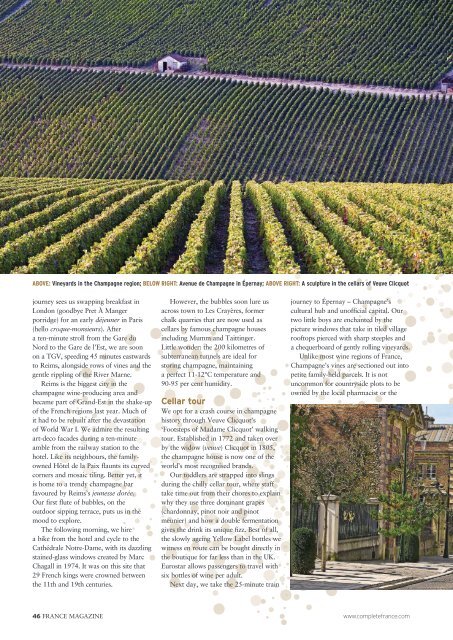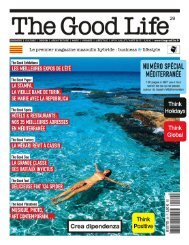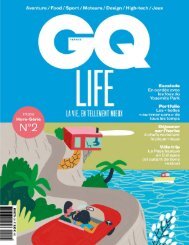You also want an ePaper? Increase the reach of your titles
YUMPU automatically turns print PDFs into web optimized ePapers that Google loves.
ABOVE: Vineyards in the Champagne region; BELOW RIGHT: Avenue de Champagne in Épernay; ABOVE RIGHT: A sculpture in the cellars of Veuve Clicquot<br />
journey sees us swapping breakfast in<br />
London (goodbye Pret À Manger<br />
porridge) for an early déjeuner in Paris<br />
(hello croque-monsieurs). After<br />
a ten-minute stroll from the Gare du<br />
Nord to the Gare de l’Est, we are soon<br />
on a TGV, speeding 45 minutes eastwards<br />
to Reims, alongside rows of vines and the<br />
gentle rippling of the River Marne.<br />
Reims is the biggest city in the<br />
champagne wine-producing area and<br />
became part of Grand-Est in the shake-up<br />
of the French regions last year. Much of<br />
it had to be rebuilt after the devastation<br />
of World War I. We admire the resulting<br />
art-deco facades during a ten-minute<br />
amble from the railway station to the<br />
hotel. Like its neighbours, the familyowned<br />
Hôtel de la Paix flaunts its curved<br />
corners and mosaic tiling. Better yet, it<br />
is home to a trendy champagne bar<br />
favoured by Reims’s jeunesse dorée.<br />
Our first flute of bubbles, on the<br />
outdoor sipping terrace, puts us in the<br />
mood to explore.<br />
The following morning, we hire<br />
a bike from the hotel and cycle to the<br />
Cathédrale Notre-Dame, with its dazzling<br />
stained-glass windows created by Marc<br />
Chagall in 1974. It was on this site that<br />
29 French kings were crowned between<br />
the 11th and 19th centuries.<br />
However, the bubbles soon lure us<br />
across town to Les Crayères, former<br />
chalk quarries that are now used as<br />
cellars by famous champagne houses<br />
including Mumm and Taittinger.<br />
Little wonder: the 200 kilometres of<br />
subterranean tunnels are ideal for<br />
storing champagne, maintaining<br />
a perfect 11-12°C temperature and<br />
90-95 per cent humidity.<br />
Cellar tour<br />
We opt for a crash course in champagne<br />
history through Veuve Clicquot’s<br />
‘Footsteps of Madame Clicquot’ walking<br />
tour. Established in 1772 and taken over<br />
by the widow (veuve) Clicquot in 1805,<br />
the champagne house is now one of the<br />
world’s most recognised brands.<br />
Our toddlers are strapped into slings<br />
during the chilly cellar tour, where staff<br />
take time out from their chores to explain<br />
why they use three dominant grapes<br />
(chardonnay, pinot noir and pinot<br />
meunier) and how a double fermentation<br />
gives the drink its unique fizz. Best of all,<br />
the slowly ageing Yellow Label bottles we<br />
witness en route can be bought directly in<br />
the boutique for far less than in the UK.<br />
Eurostar allows passengers to travel with<br />
six bottles of wine per adult.<br />
Next day, we take the 25-minute train<br />
journey to Épernay – Champagne’s<br />
cultural hub and unofficial capital. Our<br />
two little boys are enchanted by the<br />
picture windows that take in tiled village<br />
rooftops pierced with sharp steeples and<br />
a chequerboard of gently rolling vineyards.<br />
Unlike most wine regions of <strong>France</strong>,<br />
Champagne’s vines are sectioned out into<br />
petite family-held parcels. It is not<br />
uncommon for countryside plots to be<br />
owned by the local pharmacist or the<br />
46 FRANCE MAGAZINE www.completefrance.com






